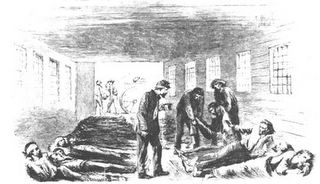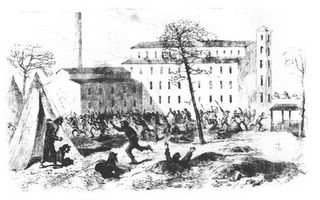
A Bird's Eye View of the Salisbury Confederate Prison

This week, Archaeologists from Wake Forest University are using ground penetrating radar in an attempt to locate the stockade boundary of the old Confederate Prison that stood in Salisbury between 1861 and 1865.
Members of the Salisbury Confederate Prison Association were on hand Wednesday morning as work began on the project. The association hopes that the data generated by the radar will provide good locations for them to begin excavation and hopefully find the evidence that will confirm the location of the outer wall, or stockade, of the prison.
If the dig is successful, it will provide the proof that the association needs to apply for a national landmark designation and will be beneficial as they seek funds for additional research.
To help the archaeologists narrow their search area, the association obtained copies of the map of the compound from the records of the 1866 court martial of Major John H. Gee, the last commandant of the prison. An image of that map was fit to scale and superimposed on a recent aerial photograph of the same area. (I have heard that another map exists of the prison. The map that the association is using is one that the US Government provided. From what I understand, there is a Confederate version of the map too. It will be interesting to see if the map the Association is using is correct!)
“The radar unit itself is a bright orange box with an antenna. As it is dragged along a straight line, the device emits a signal into the ground every 50 centimeters. The signals bounce back and are collected. Later, that information is downloaded into specialized computer software.” That software generates images that indicate anomalies in the soil. These images give archaeologists clues about what may be buried under the surface. The radar is effective to depths of 10 or 15 feet. The team conducting the search will be trying to find several tell-tale signs of the stockade wall.
First, they will be looking for evidence of the large pine posts that supported the wall. These posts were probably set between 15 to 20 feet apart. After the prison was burned by General Stoneman’s troops in 1865 the remains of these supports were probably left to decay in the ground. That process would create an irregularity in the soil composition. The ground where the post had rotted would be a different color than the dirt around it and this coloration would be in a cylindrical shape very similar to, well, a log!
The archaeologists are also hoping that the radar will help them to find the six foot deep moat that was dug around the inside of the prison wall, known to the prisoners as “Deadline Ditch.” They called it that because if you crossed into the ditch you were dead. When the trench was filled after the prison was burned in 1865, the “new” dirt put into the hole would likely have produced one of the variances that the radar could identify.
Due to overcrowding caused by the Union’s refusal to exchange prisoners, housing became a problem for the prisoners during the fall and winter of 1864 and early 1865. The prisoners’ misery was exacerbated by particularly cold and rainy conditions. Many prisoners dug holes during that time period to either escape or to try to find shelter from the elements. One of these tunnels was discovered by a city work crew in 1965 (one hundred years later!) In 1983 and 1984 Catawba College conducted archaeological digs at its site, uncovering many artifacts. It is hoped that the ground-penetrating radar will also help to locate some of these holes and tunnels.
The Association also hopes that they will be able to locate the site of the prison’s latrine.
Once the data is collected and analyzed, excavation will begin to either confirm or deny the conclusions drawn from the use of the radar.
The Salisbury Confederate Prison Association is looking for a site on which to put a museum for the prison. The Salisbury Historic National Cemetery has offered to lease a location to them, but at present, the group can't afford the lease. For more information about the association click HERE to go to their web page.
About the Salisbury Confederate Prison
Shortly after North Carolina seceded from the Union (May 20, 1861)...(to be continued)

This old mill was the central building of the Salisbury Confederate Prison.


A Copy of the Prison Rules


Though conditions were horrible inside the prison there was time for recreation. This painting is one of the oldest known pictures of a baseball game being played. There are claims that this was the first baseball game played in the South!


As the prison became extremely overcrowded in the last days of the war, conditons deteriorated for prisoners inside the compound. Disease and starvation claimed thousands of lives.


On Friday, November 25, 1864 the most ambitious and organized escape attempt ended tragically. Prisoners goaded on by starvation, disease, lack of shelter, and particularly brutal weather attempted to rush the main gate. The gate cannon was fired three times to quash the revolt and approximately 250 men died from the wounds they received.

